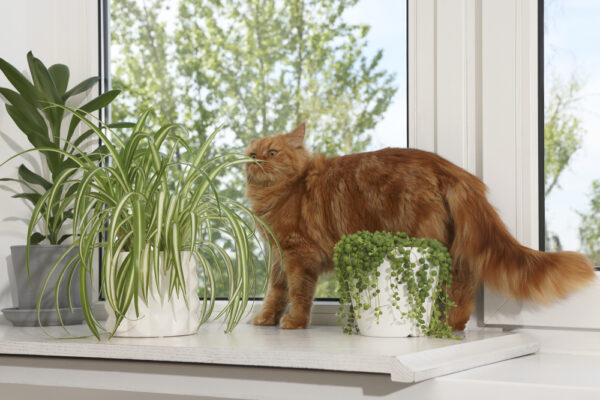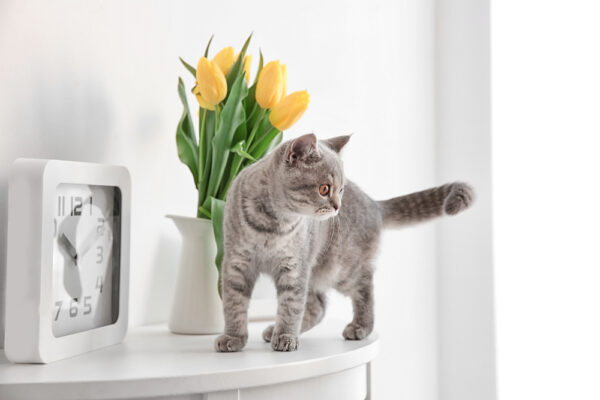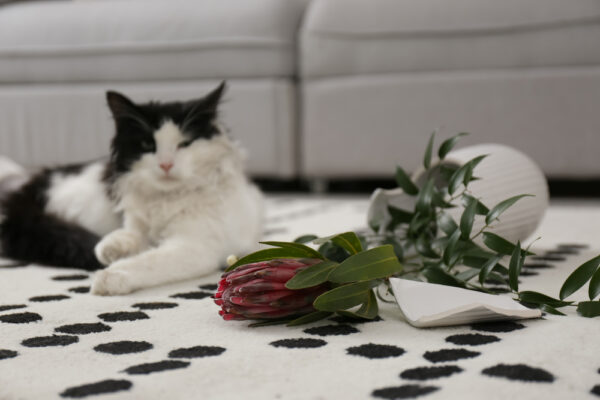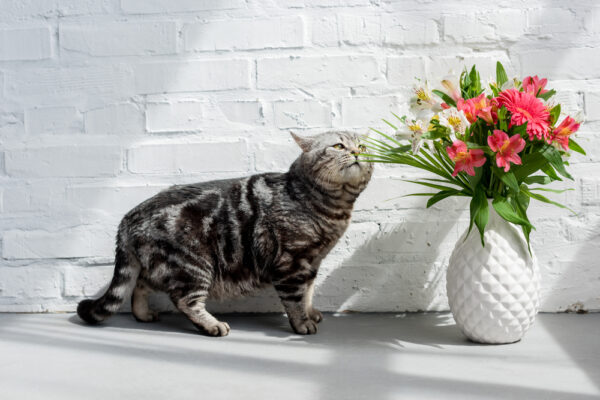
Plants Toxic to Cats
Some plants are toxic to cats. As a cat parent you need to know which plants are safe to be in your home. Our Annie is a super curious and a bit ornery so we have opted to not have any plants in our home. Sometimes we would like to bring beautiful flowers inside but we love her too much to take the risk. Because no matter how we try to keep them out of her little paw reach, even the slightest risk is not worth it to us.
cats are at risk when plants toxic to cats are indoors
All cats are known for their curiosity, and while exploring their environment, they may come into contact with various plants. However, not all plants are safe for our feline friends, and some can be highly toxic, leading to severe illness or even death. As a cat parent, it’s essential to be aware of these dangers to protect the health and well-being of your beloved pet.
Plant toxicity in cats can manifest in several ways, depending on the specific plant involved and the severity of the exposure. Some plants may cause mild gastrointestinal upset, while others can lead to more severe symptoms or target specific organs, such as the kidneys or liver. Familiarizing yourself with the most common toxic plants, both indoors and outdoors, can help you prevent exposure and recognize the signs of poisoning before it’s too late.
Key Takeaways
- Be aware of common toxic plants to protect your cat’s health
- Recognize symptoms of plant poisoning in cats for timely intervention
- Familiarize yourself with immediate actions and treatments for poisoning cases
Identifying Plant Toxicity
Identifying plant toxicity in your environment is crucial for keeping your cat safe. Many common plants, both indoor and outdoor, can pose a serious risk to cats if ingested. To prevent accidental poisonings, it’s important to familiarize yourself with the toxic plants and the symptoms they may cause.
First and foremost, research the plants found in your home and garden, focusing on their scientific names to avoid confusion. For instance, the Easter lily is a well-known toxic plant for cats, causing acute kidney failure when ingested. Additionally, some reports emphasize the importance of accurately identifying poisonous plants to prevent unnecessary emergency visits and treatments.
When introducing new plants into your home, make sure you double-check their safety for cats. Online resources, local nurseries, or even veterinary clinics can provide valuable information on plant toxicity. In some cases, a toxic plant may only affect a cat if they come into contact with a specific part of the plant or eat a certain amount. Therefore, understanding the specifics of plant toxicity can help you better protect your feline friend.
signs of plant toxicity in cats
Signs of plant toxicity in cats can vary depending on the plant and the severity of the ingestion. Common symptoms may include vomiting, diarrhea, drooling, lethargy, loss of appetite, and increased thirst or urination. If you suspect your cat has ingested a toxic plant, act quickly and seek immediate veterinary assistance. Early intervention is crucial to minimizing the risk of serious health complications or even death.
Being proactive in identifying potentially toxic plants is key to ensuring your cat’s safety. Not only will this knowledge allow you to create a cat-friendly environment, but it will also enable you to act promptly in case of accidental ingestion. Remember, prevention is always better than cure, especially when it comes to your kitty.

Common Indoor Plants Toxic to Cats
Lilies
Lilies are particularly dangerous to cats, especially those of the Lilium and Hemerocallis genera. Ingestion of any part of these plants can cause severe symptoms, such as vomiting, lethargy, organ failure, and even death. Early intervention and treatment are crucial in these cases. It is best to keep lilies out of homes with cats and opt for cat friendly, nontoxic plants instead.
Dieffenbachia
Dieffenbachia, also known as Dumb Cane, is another toxic plant for cats. When chewed or ingested, it can cause oral irritation, drooling, swelling and difficulty swallowing. If left untreated, more severe symptoms may develop, such as vomiting, breathing difficulties, or diarrhea.
Philodendron
Philodendron plants contain calcium oxalate crystals, which can lead to oral irritation, drooling, difficulty swallowing, and vomiting in cats. If you suspect your cat has ingested any part of a Philodendron, it’s essential to seek veterinary care as soon as possible.
Pothos
Pothos, also known as Devil’s Ivy, is toxic to cats due to the presence of insoluble calcium oxalates. When ingested, this plant can cause oral irritation, difficulty swallowing, drooling, and vomiting. Immediate veterinary care should be sought if a cat is exposed to Pothos.
English Ivy
English Ivy, which contains compounds called triterpenoid saponins, can be toxic to cats if ingested. Symptoms include drooling, vomiting, diarrhea, abdominal pain, and possible hyperactivity. It is essential to quickly seek veterinary care if your cat has ingested any part of an English Ivy plant.
Oleander
Oleander, although more commonly found outdoors, can sometimes be grown as an indoor plant and is highly toxic to cats. All parts of the Oleander plant contain cardiac glycosides, which can cause severe symptoms, such as vomiting, diarrhea, irregular heart rate, seizures, and even death. If your cat has ingested any part of an Oleander plant, urgent veterinary care is crucial.
Common Outdoor Plants Toxic to Cats
In this section, we will discuss various outdoor plants that are toxic to cats. It is important for cat guardians to be aware of these plants to keep their feline friends safe.
Foxglove
Foxglove is a beautiful flowering plant that can be hazardous to cats. When ingested, it affects their heart and can lead to symptoms such as drooling, vomiting, diarrhea, and even heart failure. Cat parents should be cautious when planting foxglove in their gardens and ensure that their cats don’t have access to these toxic plants.
Rhododendron
Rhododendron is another toxic plant for cats. If ingested, it can cause symptoms like drooling, loss of appetite, vomiting, diarrhea, and weakness. In severe cases, it may even lead to coma and death. It is best to keep these plants away from areas where your cat may roam.
Azalea
Azaleas are popular outdoor plants due to their vibrant colors and lush foliage. However, they are also dangerous to cats. Ingesting azaleas can cause similar symptoms as rhododendron and may result in severe health issues.
Crocus
Although the Crocus plants add a touch of color to spring and fall gardens, they pose a threat to cats. The spring variety can cause gastrointestinal issues in cats, while the autumn crocus is even more toxic, leading to organ damage or failure, seizures, and potentially death.
Tulips and Hyacinths
Tulips and hyacinths are beautiful spring-blooming plants that can be harmful to cats. The toxic parts are mainly in the bulb, but all parts of these plants can cause irritation and gastrointestinal issues if ingested by cats.
Autumn Crocus
The autumn crocus (different from the spring crocus mentioned earlier) contains a higher level of toxicity for cats. When ingested, it can lead to severe vomiting, diarrhea, organ failure, and even death. It is essential to keep cats away from this plant to avoid any potential harm.
In conclusion, it is crucial for cat parents to be aware of the various toxic outdoor plants that may harm their cats. By keeping these plants out of reach or opting for non-toxic alternatives, you can create a safer outdoor environment for your feline friend.

Symptoms of Poisoning in Cats: Plant Toxicity in Cats
Cats can be affected by various toxic plants, and it’s crucial for cat parents to understand the symptoms of poisoning in order to help them promptly. Clinical signs of toxicity in cats may vary depending on the specific plant ingested, the amount consumed, and the individual cat’s sensitivity.
One of the most common toxic plants for cats is the lily, which can cause severe kidney failure. Symptoms of lily poisoning include vomiting, drooling, and a lack of appetite. Ingestion of even small amounts of lily can lead to these symptoms within a few hours source.
Gastrointestinal symptoms such as vomiting, diarrhea, and abdominal pain can occur if a cat consumes a toxic plant like the sago palm. Extreme thirst, lethargy, and weakness can also be observed when a cat ingests this type of plant.
Additionally, some cats may exhibit neurological symptoms like muscle tremors, lack of coordination, and seizures after consuming toxic plants, like the autumn crocus. In some cases, changes in heart rate and breathing rate may be observed, pointing to possible cardiovascular issues.
Decreased red blood cell count can be a sign of poisoning in cases where cats consume plants like onions or garlic. Symptoms may include pale gums, rapid heartbeat, and difficulty breathing.
In conclusion, monitoring your cat for the various symptoms of poisoning is essential for detecting and addressing plant toxicity. If you suspect your cat has ingested a toxic plant, contact your veterinarian immediately for guidance and treatment options.
Immediate Action Steps
If you suspect your cat has ingested a toxic plant, it’s essential to remain calm and take immediate action to minimize potential harm. The following steps provide guidance on what to do in such situations:
- Identify the plant: If possible, determine the specific plant your cat has come into contact with. This information will be helpful when seeking professional medical advice for your cat. If you are unable to identify the plant, take a sample of it with you when you consult a veterinarian.
- Remove the cat from the source of danger: Ensure your cat is no longer around the toxic plant, and prevent them from returning to the area until the hazard has been safely removed.
- Assess symptoms: Observe your cat for any signs of distress or discomfort, such as vomiting, drooling, difficulty breathing, or lethargy. Make a note of these symptoms as they will be useful when discussing your cat’s condition with a veterinarian.
- Call a veterinarian: Always consult your veterinarian or a pet poison helpline for advice and guidance on the next steps. Provide as much information as possible about the plant, symptoms, and time since exposure to help them assess the situation.
- Follow the veterinarian’s advice: Once you have contacted a veterinarian or a pet poison helpline, follow their recommendations on what to do next. This may include administering medication, bringing your cat to a veterinary clinic, or monitoring your cat closely at home.
Remember, timely action can significantly increase the chances of a positive outcome for your cat. By educating yourself on the types of plants toxic to cats and taking immediate action steps if your cat is exposed, you can help keep them safe and healthy.

Treatment and Recovery Procedures
When a cat has ingested a toxic plant, it is crucial to act quickly and follow appropriate treatment and recovery procedures. The first step is to remove any plant material from the cat’s mouth and take note of the plant’s name. If possible, bring a sample of the plant to the veterinarian’s office for identification.
Next, consult with your veterinarian immediately. They might instruct you to induce vomiting with hydrogen peroxide based on the specific plant ingested. However, inducing vomiting is not always appropriate. Certain toxic plants may cause further harm to the cat’s esophagus if vomited, and some cases might require immediate veterinary attention without inducing vomiting.
At the veterinary clinic, the veterinarian will assess the cat and provide the necessary treatment. Treatments may include administering activated charcoal to help bind the toxins and prevent further absorption, and IV fluids to support hydration and help flush the toxins from the body. In some cases, the cat might require oxygen therapy, medications to address specific symptoms, or even hospitalization for further observation.
The recovery process varies depending on the specific toxin ingested and the severity of the poisoning. It may take hours to days for a cat to recover from mild to moderate poisoning. During this time, providing a quiet and comfortable environment for your cat is crucial. Ensure that they have access to fresh water and monitor their food intake. Your veterinarian may also recommend follow-up appointments to monitor your cat’s progress and any potential complications.
Prompt action and appropriate treatment are key to successful recovery from plant toxicity in cats. Be sure to consult with your veterinarian immediately if you suspect your cat has ingested a toxic plant.
Preventive Measures
It is essential to protect our feline friends from toxic plants that could cause harm or illness. The following preventive measures can be taken to keep cats safe from dangerous plants:
- Identify and Remove Toxic Plants: Familiarize yourself with the list of toxic plants for cats, such as lilies, azaleas, and tulips. If you have these plants in your home or garden, consider removing and replacing them with cat-safe alternatives spider plants.
- Restrict Access to Certain Areas: Create designated spaces for your cat, especially if you have house plants or a garden with potentially harmful plants. Limit their access to these areas by using barriers or closed doors.
- Provide Safe Alternatives: Keep cats entertained and engaged with plants that are safe for them, such as catnip or cat grass. Providing pet-friendly greenery can deter your cat from exploring potentially dangerous plants.
- Educate Your Community: Share information about toxic plants with friends, family, and neighbors. A collective effort to keep dangerous plants out of the shared environment can help prevent accidental poisoning.
- Seek Veterinary Advice: Consult with your veterinarian about toxic plants that may affect your cat. A professional opinion can help you make informed decisions on how to protect your pet.
By implementing these preventive measures, cat parents can create a safer environment for their cats and reduce the risk of plant-induced illnesses. Keep in mind the importance of continuous vigilance and regular updates on new plant species to ensure your cat’s safety.

Frequently Asked Questions
What common houseplants are harmful to cats?
Several common houseplants can be toxic to cats, including lilies, English ivy, and dumb cane (Dieffenbachia). These plants contain compounds that can cause a range of symptoms if ingested, from gastrointestinal distress to organ damage or even death. To keep your cat safe, it’s important to be aware of the plants in your home and ensure they’re non-toxic. For a more comprehensive list of toxic plants, refer to the ASPCA’s guide on poisonous plants for cats.
Which flowers should be avoided around cats?
Some flowers, such as lilies, can be particularly dangerous for cats, as even a small ingestion can cause severe kidney damage or death. Other flowers to avoid include tulips, daffodils, and azaleas. For a complete list of toxic flowers, consult resources like the ASPCA’s poisonous plants guide.
What signs indicate a cat has ingested a toxic plant?
Symptoms of plant toxicity in cats can vary but often include vomiting, diarrhea, increased salivation, lethargy, difficulty breathing, or seizures. Additionally, some plants may cause skin irritation. If you suspect your cat has ingested a toxic plant, it’s crucial to consult a veterinarian immediately.
How can I prevent my cat from eating poisonous plants?
To prevent your cat from ingesting toxic plants, keep such plants out of reach or, even better, don’t have them in your home. Regularly inspect outdoor areas for toxic plants, and remove them as necessary. Additionally, offer cat-safe plants as an alternative, providing a safe option for your cat to nibble on.
What should I do if my cat eats a toxic plant?
If you suspect your cat has ingested a toxic plant, contact your veterinarian immediately. Do not wait for symptoms to appear, as early intervention can be crucial for successful treatment. If possible, identify the plant swallowed and provide this information to the veterinarian to help determine the course of action.
Are there any catt-friendly alternatives to toxic plants?
Yes, there are several cat-friendly plants that can be safely incorporated into your home. Examples include spider plants, Boston ferns, and Swedish ivy. These plants are not only non-toxic but can also provide enrichment for cats that enjoy nibbling on greenery. Be sure to choose plants that are safe for your specific pets, as some plants may be toxic to other animals.